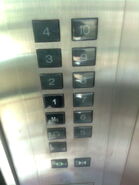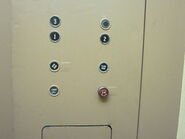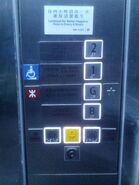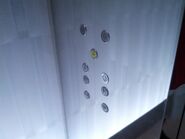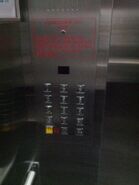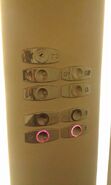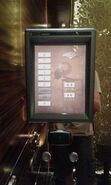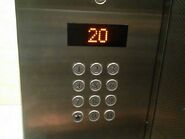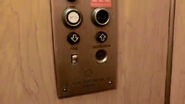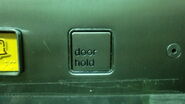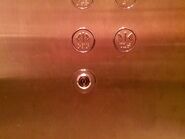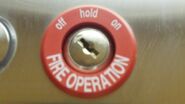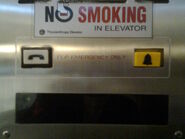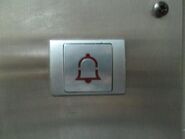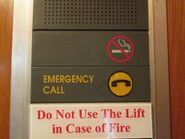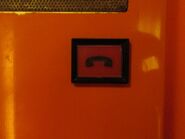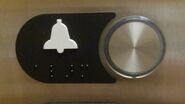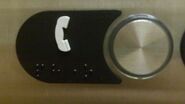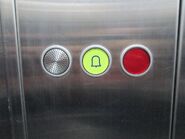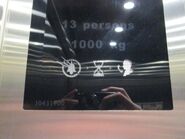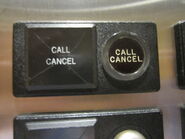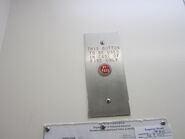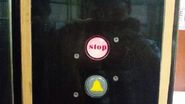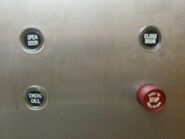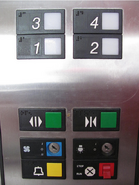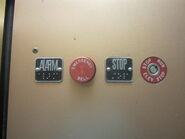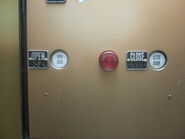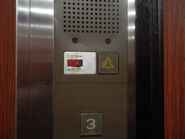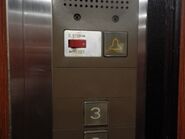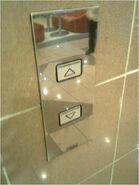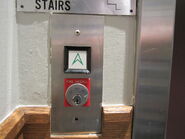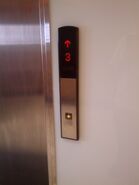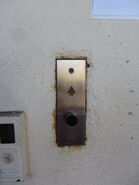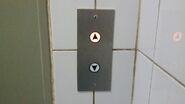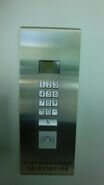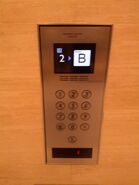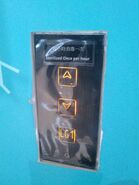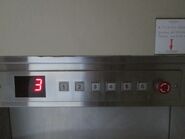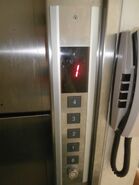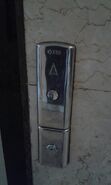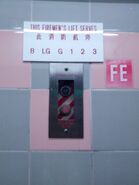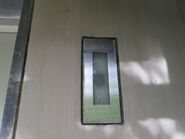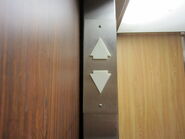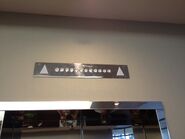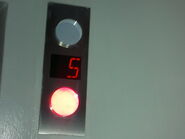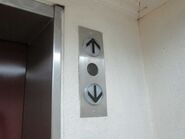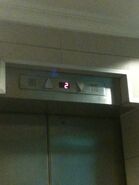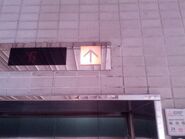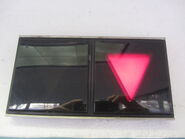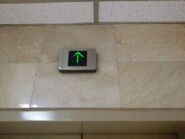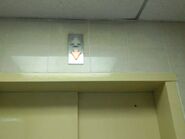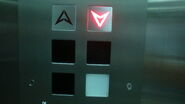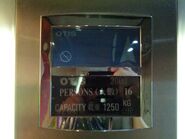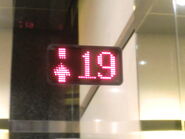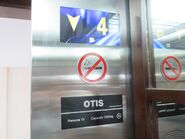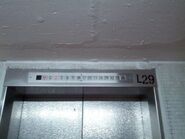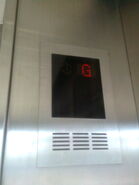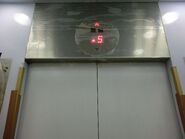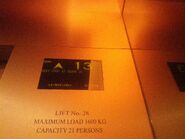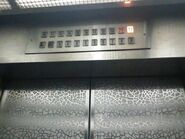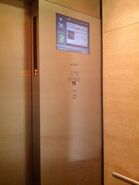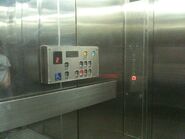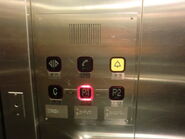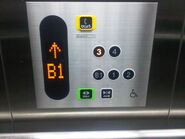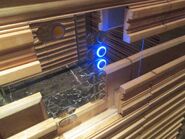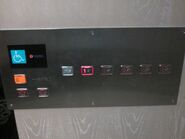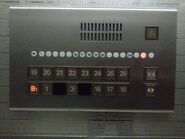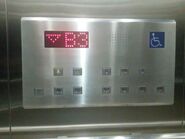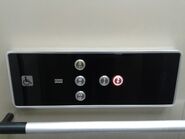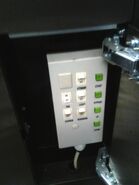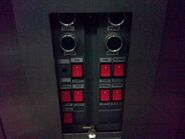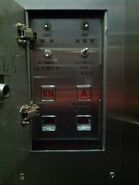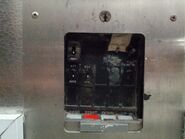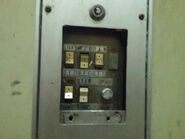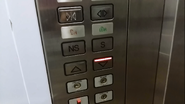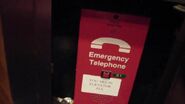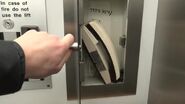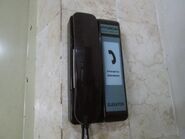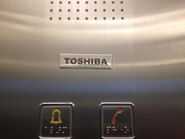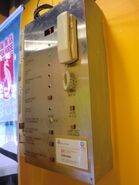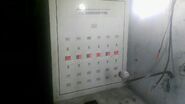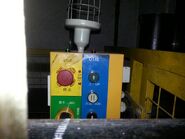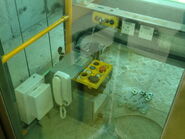Elevator fixtures are the set of buttons, floor indicators, hall lanterns and other things for elevators.
Car buttons
Deadman Controls
- Main article: Old Deadman controls
Floor buttons
These buttons are used to register the floor where you want to go to. When pressed, the button or the floor number will light up in most newer elevators. some elevators may have dual illumination to meet DDA standards in the UK and Australia. All the floor buttons are needed in the elevator car except the car included in a group of Destination Dispatch System.
Before in the 1970s, most buttons were not equipped with illuminating lamps, instead they only had floor numbering written on the buttons. If fitted with pop-out buttons, the button will "pop-out" when the elevator arrives at your destination (if you first registered your destination in the elevator). If the wrong button is pressed, pulling the button or pressing a "stop" button will cancel the call.
In the 1970s, buttons were equipped with illumination lamps. Also in this era, touch-sensitive buttons were quite common, although these proved to be problematic and unreliable. In the 1990s onwards, most of the elevators are now using LED illumination lamps in their buttons. Some countries may need to present the braille on the buttons (and may need a "star" to indicate the main entrance level) for accessibility reasons. Sometimes, this also applies to the door control buttons, alarm/phone buttons and call buttons.
With the progresses in technology since the 1990s, some elevators are controlled by destination dispatch systems. The floor is selected from the outside, by a keypad.
If an elevators has more than one exit on the same floor, that elevator may have two buttons for same floor. One of this is direct to front door, the other one is connected to the rear door. Each button operates one exit. On some elevators with many exits on the same floor, there can be only one button, and the doors open automatically on both sides.
On some elevators that only serve 2 floors, there will only be 1 floor button. Pressing the floor button takes you to the floor you are not currently on. This feature is mainly seen in the United Kingdom.
Some modern elevators (like Mitsubishi and Schindler) may have a keypad-style floor buttons. Passengers key in their desired floor number and the number will be displayed above the buttons. There is also a button to select a main or exit floor, usually marked by a star. A button for underground floors is usually marked by negative "-" or B, this button is pressed first followed by the floor number. Those buttons may contain braille and with voice guidance when button pressed for accessibility reasons[1][2].
Some newer elevator systems (like Mitsubishi and Fujitec) may contain call cancellation to cancel the floor you registered if you pressed a wrong floor.[3]
Nowadays, some elevator companies offers touchscreen fixtures to be used as the button panel. However, they cannot be used in buildings or countries with building codes which do not allow the use of such fixtures for accessibility reasons.
Inch up and inch down buttons
"Inch up" and "inch down" buttons are usually installed in older automatic service/freight elevators to re-level the floor manually to make loading of freight easier. This system is no longer used in modern elevators as the controller automatically re-levels the elevator.
Door control buttons
- Main article: Elevator door control
Door open button
The door open button is used to re-open the doors when they are closing. It is also used to hold the door open when it is kept pressed. This button is mandatory for door control buttons.
Door close button
The door close button is used to close the doors immediately. Some older elevators and few modern elevators may not have a door close button[4][5], instead, pressing a floor button will cause the door to close immediately (although door delay also exists). On some elevators in America, the door close button does not work, except in fire/independent service.
Door hold/door delay button
The door hold or door delay button is used to hold the door open for a desired period (normally up to five minutes) for loading goods, baggages, bed or strecher. This button is normally found in bed and freight elevators, and often in normal passenger elevators as well.
Keyswitches
Keyswitches are for people carrying their respective service key only. They're usually located inside a locked service cabinet panel in the US. There are independent service, fire service, fan, light, electric eye/sensor, attendant service, hand service, emergency light test, and stop key switches, which are activated by different types of keys.
"Firefighters' Operation" Cabinet
This cabinet is for the elevators comply the U.S. National Fire Code which revised in 2004. This make the Call Cancel button, Fire Hat indicator, Emergency Stop Switch, and door control buttons, Fire Service Phase 2 keyswitch, and Fire Service Instructions Sign move inside the cabinet[6].
Alarm/phone buttons
- Main article: Elevator emergency communication system
These buttons are used to summon help trapped passengers when the elevator is broken or has malfunctioned. In older elevators and newer elevators with both alarm and phone buttons, the alarm button only rings the alarm and the phone buttons only calls for help. In some elevators, the alarm has to be kept pressed to summon help, while some elevators have their alarm ring for a few minutes after you pressed it. This button is mandatory installed in the elevator.
In modernized elevators or newer elevators with only alarm button, the alarm button may both ring the alarm and call for help. In newer elevators with only phone button, the phone button may either call for help or both rings the alarm and calls for help. Some modern elevators also have the alarm button synchronized with an automatic elevator monitoring system, which the system is activated when the alarm button is pressed. Some of the examples are Otis REM (Remote Elevator Monitoring), Schindler Servitel, Mitsubishi MelEye, KoneXION, etc.
Some elevators (like Kone and Mitsubishi) may have alarm indicator lamps on the car operating panel to guide passengers in case of entrapment. However, the "speak" indicator is not exclusive to these two companies (because some countries is a standard for the disabled in designated elevator for the disabled[7]. see Emergency telephone or Intercom section).
Call cancel button
This button cancels all car calls in American elevators. These buttons only work in fire service and sometimes independent service.
Call cancel buttons are also often found in Soviet elevators, in these elevators they often work in all modes.
To be used in case of fire only buttons
These buttons are not seen on modern elevators (as the modern fire service mode already disables sensors). These buttons are exclusive to California, because of codes. This button disables sensors, so the door can close if there is smoke blocking the sensors. It is unknown if the elevator has to be in fire service mode for these buttons to work. Some elevators with this button might not have fire service.
Emergency Stop button/switch/keyswitch
These buttons/switches are used to stop the car in case of emergency or just for loading purpose, especially in service or freight elevators. Some stop switches are either flip type (like some older Mitsubishi, Hitachi and GoldStar elevators) or push-and-pull type (like most old Otis elevators). The elevator cab will not start until the button/switch/keyswitch is reset. They are normally found in older elevators installed before 2000s, and rarely found on most modern elevators nowadays.
Hall buttons
Call buttons
These buttons are used to register what direction you want to go. When pressed, the button or the arrow will light up in most elevators (either new or old) but some older fixtures don't have any illuminating on the buttons, this will have a separate indicator that lights up when the button pressed and the call is accepted.
Destination dispatch keypad
In an elevator bank included in a group of Destination Dispatch System, the lobby may have a keypad to let the passengers enter their own floor destination before they get in the elevators. This also can be synchronous with the building security systems by using their own pass card (for example, Schindler ID).
Floor button(s)
For any elevators group, may have some elevators served floor other than the group mainly serving. The call button panel will have a extra floor button for calling the elevator served the specific floor. When the button is pressed, the elevator system will order the elevator which served the specific floor to the floor where that button pressed. This button is running independently, other than elevators group.
The external floor buttons are also implemented to dumbwaiters because there is no floor buttons inside.
Keyswitches
The keyswitches outside the elevators are often found on the main floor such as Fire Service, out of service (or STOP/RUN in some countries) and Access Keyswitch.
Fireman's switch
- Main article: Fireman's elevator
Fireman's toggle switch is usually found for countries in Asia and United Kingdom[8] to activate fire service mode. This switch is usually protected by a glass cover to prevent abuse.
Arrival lanterns
The arrival lanterns are usually located outside of the elevator either to the side or above the door (some may not be equipped with one as it is optional), on the inside door jamb and/or on the elevator's wall in some old or American elevators. They will light up along with the chime sound when the elevator is about to arrive, according to the direction that the elevator will go. Usually, lanterns illuminate in three different color combinations, which include white up/white down, white up/red down, and green up/red down, although there are other color combinations as well. Some elevators from Japanese manufactures, such as Fujitec and Mitsubishi have lanterns that illuminate steady when a call is registered, and then flashes when the elevator arrives.
Directional indicators
The directional indicator is present in some elevators since 1950s. It is used to indicate the direction that the elevator is currently going. They are mostly located above or next to the floor indicator, on separate indicator with the floor indicator, or combined with the floor indicator (refer to floor indicators section).
Floor indicators
The floor indicators are located inside and/or outside of the elevator. It is used to indicate the floor that the elevator is currently on.
Old elevators in the late 19th to early 20th centuries were using old-style dial indicator with moving arrow or rotodial numbers with static arrow. These arrow indicates the position of the car. However, dial indicators are still used in some modern elevators.[9]
Sometime in the 1940s to 1990s, elevators began to use floor counter bars with illuminating floor numberings or lamps. Then in the 1970s onwards, elevators are starting to use digital-segmented displays (nowadays they are usually LEDs). Some elevators, mostly Asian elevators, have TV-style floor indicators.
Destination indicators
For the elevator cars included in a group of Destination Dispatch System. They need to use the destination indicators which replace the floor buttons to display which floors will be go to.
Car operating panels for wheelchairs
These are smaller car operating panels which are mounted horizontal and lowered by wheelchair height on the side wall of the elevator cab to provide accessibility to those on wheelchairs so that they don't need to reach for the main car operating panels which are mounted vertically. They can also functions as an additional car operating panel so that passengers do not need to turn around to use the main car operating panels, especially on crowded elevators. These panels have set of floor, door control, and alarm buttons (often with braille on them or braille plates as an additional) as a mandatory, international symbol for wheelchair, and sometimes floor indicator and intercom speaker. They can be either mounted directly on the wall or comes in a boxless type.
In Japan and other countries, it is mandatory to install additional car operating panels for wheelchairs on elevators installed in railway and subway stations.
Floor announcement
Floor announcement are automated audible voice sounds which is used to inform passengers about the elevator's current floor landing, travel direction (up or down) and other sounds (Such as "Lift overloaded! Please reduce the load!"[10]). Most elevators have the floor announcement announced the current floor landing (such as "Floor 1"[11][12], "1st Floor"[13][14], etc.), current elevator travel direction (such as "Going up/down"[15][16], "Lift going up/down", etc,) and voices that tells passengers that the doors are open and closing (such as "Doors opening[17][18]/closing"[19][20], "Doors open/close", etc.).
Floor announcement in some countries which is a standard for the disabled in designated elevator for the disabled (like Hong Kong[7]).
Inspection switches
Inspection cabinet is a cabinet that contains buttons and switches used for elevator maintenance or inspection purposes. Some older elevators may not have such cabinet (just contain switches and/or keyswitches) but most modern elevators now have this cabinet secured by a lock using a key. Elevator inspection switches mostly contains the following switches:
- Fan: to turn on or off the elevator ventilation fan.
- Light: to turn on or off the elevator cab lamp.
- Attendant: to activate or deactivate attendant service mode.
- Isolation: to isolate the car from group control and hall calls during inspection service mode. This switch is rarely found in most elevators.
- Bypass (or non-stop): to skip or bypass hall calls under attendant service mode. On some older Otis and Schindler elevators from the 1960s to 1980s (or the buttons are using generic fixtures), the button is usually marked as "NS" and it is normally located below the floor buttons.
Additionally, an elevator inspection switches also contains some buttons that are used during inspection service mode:
- Up: to move the car up (not to be confused with inch up button).
- Down: to move the car down (not to be confused with inch down button).
- Start: to start the car.
- Stop/Run: usually a toggle switch which is used to run or stop the car during inspection service mode.
Inspection switches are found inside the elevator car and located below the car operating panel. Elevator inspection switches are usually locked out behind a metal cabinet to prevent misuse operation by passengers.
Emergency telephone/Intercom
- Main article: Elevator emergency communication system
Elevators may also be equipped with emergency telephone or intercom for passengers to summon help in case that they are trapped inside the elevator (include the power failure). Elevator emergency telephone is a device for two-way conversation between the elevator car and a readily accessible point outside the hoistway (like machine room/MRL control panel etc. For any other locations, please refer to "supervisory panel" section below) that is available to emergency personnel[21]. In the United States, it is a requirement for all elevators travelling 60' or more to be equipped with emergency telephone due to the ASME compliant code (A17.1). Most of this device installed is a one-button "hands-free", programmable, automatic-dialing emergency telephone that meets with the requirements of the ICC/ANSI code (1998).[22] Most ADA (Americans with Disabilities Act) phones equipped in elevators are normally placed hidden behind a cabinet below the car operating panel. Elevators in Australia also require an emergency telephone to be equipped due to the DDA (Disability Discrimination Act) requirements.
In most modern elevators, emergency intercom may be activated by a separated panel designed for intercom or a special button located on the elevator control panel (normally identified by a telephone symbol). Some elevators may also have the emergency intercom activated by pressing the alarm button instead of the telephone button.
Intercom in some elevators in Hong Kong is quite different than other Asian countries. There will have a indicator as same as United State for acknowledgement. There also have a reminder below to let the passengers know the rescue is on the way to meet the government standard "Barrier Free Access (2008) (or BFA 2008)"[7] and even older standard "Barrier Free Access (1997) (or BFA 1997)".[23]
Supervisory panel
A supervisory panel is a circuit-board-based station for building manager to take a look what status for the elevators (and escalators), where the elevator cars located and controlling the elevator's service modes. These usually founded in the buildings with newly installed and modernized elevators[21] (and escalators) since 1981 (when Hopewell Centre in Hong Kong, China completed) and much more popular since 2000s (for updated safety code). It usually located in the security room, security counter, building reception, building management office or the main entrance level.
Supervisory panel can also receive the alarm signal from the elevators (and escalators) to the building manager and contact to the people who need for help in the elevators by emergency telephone/intercom, it can also to be contacted to the machine room.
Annunciator panel
An annunciator panel is a relay-based panel for building manager or security to take a look for the elevator's status, position, peak up/down status, and controlling the elevator's service modes. It also has a speaker and an intercom for security to communicate with passengers inside the cab in case of entrapment (however, it cannot contact to the machine room). Commonly found in older mid to high-rise elevators (especially older automatic programmed elevators, such as Otis Autotronic), this panel is located outside the elevators on the main entrance level. This panel has since been replaced by supervisory panel in the 1980s (see above).
Car top inspection switches
To be added.
References
- ↑ Talking Schindler Traction Elevator @Harbour Grand, Hong Kong
- ↑ 沙田麗豪酒店Schindler升降機
- ↑ hkelev.com - call cancellation video clips (This example is using Toshiba)
- ↑ GEC Express Traction Elevator at Malahon Centre, Central, Hong Kong
- ↑ Otis M.R.L.(Machine-Room-Less) Traction Elevator at Apple Store(HK), Hysan Place at Lee Gardens, Causeway Bay, Hong Kong
- ↑ Signal Fixtures (ThyssenKrupp Elevator Americas)
- ↑ 7.0 7.1 7.2 Design Manual : Barrier Free Access (2008), Division 19 - Lifts
- ↑ In the United Kingdom. The fireman's toggle switch was recently changed to fireman's triangle-shaped keyswitch. Same method as Asian toggle switch version.
- ↑ Just for decorations only but it work.
- ↑ Lift Overloaded
- ↑ Tour of the lifts at 6 Burlington gardens art gallery
- ↑ Tour of the lifts - NEW STYLE
- ↑ Otis Gen2 Traction Elevators at Sandy Beach Resort in Myrtle Beach
- ↑ Fujitec Traction Elevator at Youth Square,Chai Wan,Hong Kong
- ↑ Otis Traction Elevator at Harbour Plaza 8 Degress Hotel , To Kwan Wan , Kowloon , Hong Kong
- ↑ ThyssenKrupp M.R.L.(Machine-Room-Less) Traction Elevator Jordon Centre, Jordon, Kowloon, Hong Kong
- ↑ Schindler Traction Elevator at Jockey Club Hall, Centennial Campus, Hong Kong University, Pok Fu Lam, Hong Kong
- ↑ Lift at flats in Seaford
- ↑ [Happy Songkran Day] Sivatel Bangkok: Kone Traction Elevators
- ↑ Schindler Traction elevator Elevator at Hong Kong International Trade & Exhibition Centre, Kowloon Bay, Kowloon, Hong Kong
- ↑ 21.0 21.1 Guidelines for Modernising Existing Lifts (Electrical and Mechanical Services Department, Hong Kong)
- ↑ Emergency Telephones in Passenger Elevators and Vertical Platform Lifts requirement codes (PDF)
- ↑ Design Manual : Barrier Free Access (1997), Chapter 5 - 5.7 Lifts
See also
- List of elevator fixtures guide - for a complete guide to some notable elevator fixtures found in most elevator brands.
